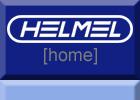 |
|
 |
 |

|
|||||||
 |
|
Article # 4 |
||
|
Air Bearing Rigidity |
||
|
If a machine tool salesman was trying to convince you to purchase a Machining Center that was constructed with air bearing movement, you would very likely have serious reservations about that machine's ability to operate accurately and reliably. You might correctly surmise that side loading on the spindle would cause some air pads to bottom out while others open up, momentarily compromising machine geometry perhaps seriously, causing inaccuracy and potential damage to the air pads and/or the ways. The salesman would need arguments that defy the laws of physics to win you over. Similar logic prevails when one considers CMM construction. A CMM is not normally subject to the forces induced in metal cutting, but inertial forces still contrive to alter the repeatably, straight and square characteristics which are desired in the three axes of motion. CMM operation today is still, to a large extent, a manual process utilizing a touch trigger probe. Measurement is taken "on the fly" or dynamically. On a manual machine you hold the probe bar (Z-axis) and move the machine towards the work piece. If you move too fast with an air-bearing machine, with speeds we would consider normal, you will create a condition as depicted in figure 1. The air gap of some pads would compress while some open up, distorting the CMM geometry and leading to erroneous readings.
Therefore air bearing manufacturers recommend a "settling time" to allow the machine to recover as much of this basic geometry as possible, reducing the potential for error. In our opinion, this defeats the primary purpose of a CMM, to accurately check parts as fast as possible. Some builders of air bearing CMMs instruct the user that the proper way to handle the machine is to keep the hands off the probe bar. In contrast, a mechanical bearing CMM, with direct contact between bearings and ways, offers structural rigidity even when on the fly. This rigid dynamic machine geometry is ideal for manual CMM inspection techniques. At Helmel, we teach the use of the probe bar. It seems a more natural way to use the machine and certainly results in faster inspection. The machines operate swiftly and accurately and gives the operator a confident, solid feel. Air bearing machines tend to drift if not leveled perfectly. A side benefit of mechanical bearings related to reliability has to do with the very minimal amount of inherent friction they provide. A properly leveled machine will not drift when the probe bar is released, and therefore will not accidentally take unwanted points. Watch any operator of a manual air bearing machine; to overcome this annoyance the most frequently used features are the X and Y locks. We would certainly agree that the DCC environment is better suited to air bearing construction than manual use is. Since the driving force is applied closer to the ways the condition as per figure (1) is greatly diminished in normal applications. However, DCC machines are becoming faster and faster. An air-bearing machine will reach speed limitations long before a mechanical bearing machine. Rapid directional changes and acceleration rates will cause air bearings to bottom out, score and damage themselves. They are not durable enough for high-speed applications. It is interesting to note that, where high speed or harsh environments are anticipated, mechanical bearings are used. The Sheffield Discovery II Series is an example of this. We would argue that mechanical bearing construction is the best all around approach, whether manual or DCC, but especially when a machine may be used in both modes. |
||
|
